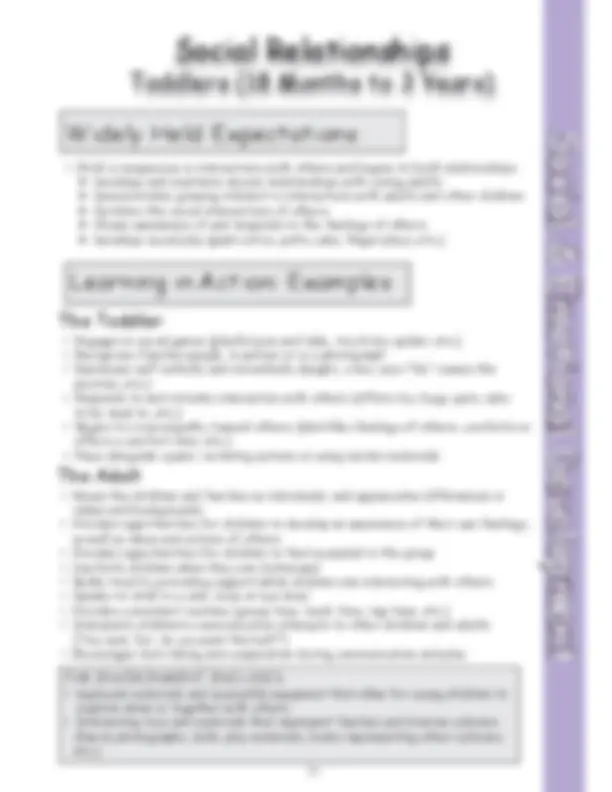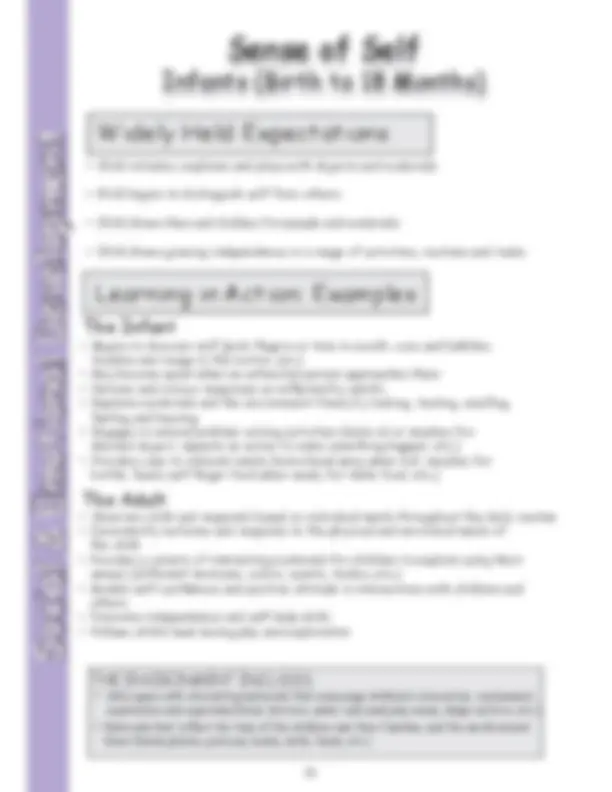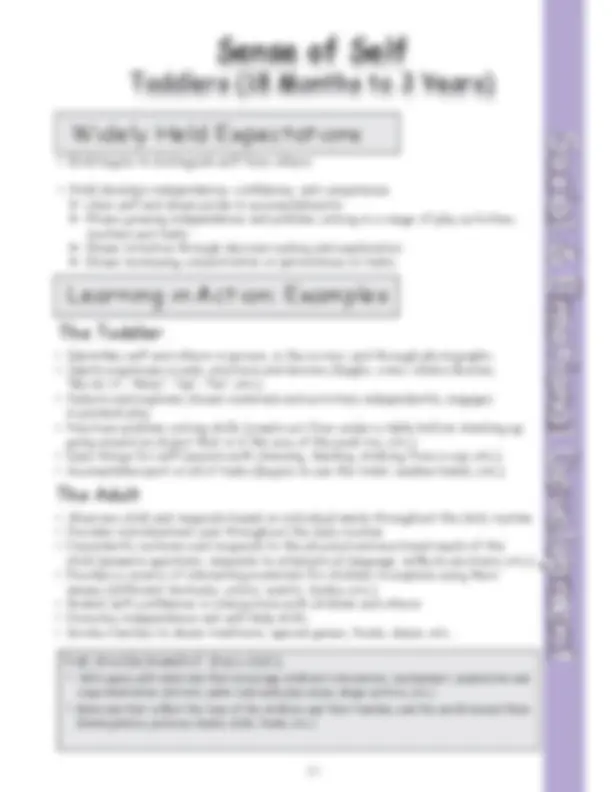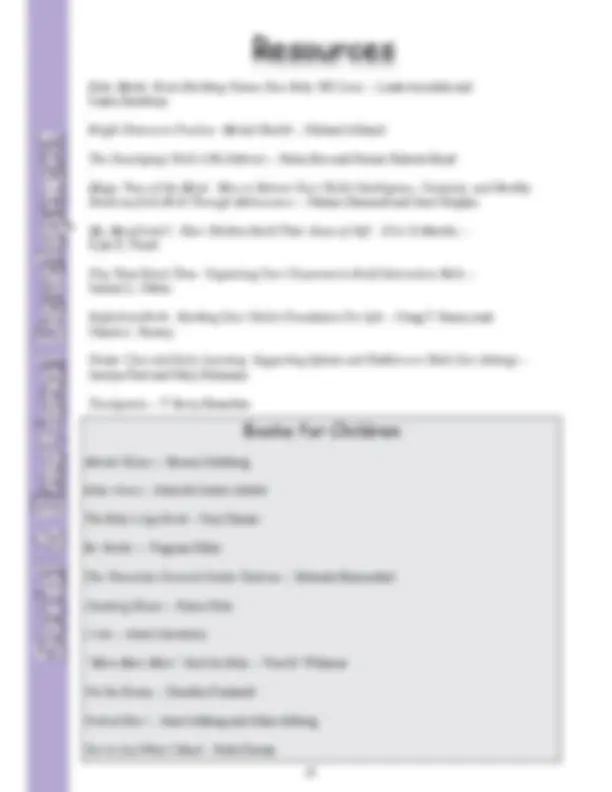Download Strategies for Emotional & Social Development in Young Children: Environments and more Study notes Communication in PDF only on Docsity!
Social and Emotional
Development
One of the primary goals of a quality program for infants and toddlers is to foster social and emotional development. When babies and young children feel emotionally and physically secure, they have the opportunity to freely explore their environment. They are able to interact with adults and other children, and gain a sense of identity through an understanding and confidence in themselves as individuals.
The key to social and emotional development is strong, positive, secure relationships. Infants and toddlers need consistent, nurturing adults who are supportive and responsive. Caring adults provide safe, stable, and predictable environments that support young children‛s growing independence. Such environments promote a healthy sense of self and connections with others.
Strategies to support inclusive learning environments:
Carefully observe child to child and child to adult interactions, and provide opportunities that will promote positive relationships Provide opportunities for natural, ongoing interactions with typically developing and socially competent peers Provide choices so children have more control over their environment
Some general accommodations to support children with special learning or developmental needs can be found on page 9 of this document, and in NDE Rule 5 1.
- Social Relationships • Self Regulation
- Sense of Self
Widely Held ExpectationsWidely Held Expectations
Social & Emotional Development
Social RelationshipsSocial Relationships
Infants (Birth to 18 Months)
- Child is responsive in interactions with others and shows evidence of attachment process Develops an attachment with caring adults Begins to develop a curiosity about others Shows an interest in things in the environment Displays pleasure when with familiar people
- Responds to familiar adults‛ and childrens‛ interactions (gazes, cuddles, accepts assistance from familiar adult, etc.)
- Engages in social games with familiar people through playful back and forth interactions (exchanges smiles, coos, plays peek-a-boo, etc.)
- Expresses self using verbal and nonverbal cues (cries, laughs, turns head away, reaches for familiar adult, etc.)
- Knows and builds a trusting relationship with each child
- Understands and responds to different temperaments of children
- Provides opportunities and participates in back and forth communication (uses eye contact and allows sufficient time for children to respond)
- Interacts playfully with babies, verbally describes infants‛ actions
- Meets infants‛ bodily needs for comfort (responds to cries, holds baby when bottle feeding, makes eye contact while diapering, etc.)
- Provides opportunities and support to help children develop close relationships with caring adults (responds to children‛s cues, talks to them during routine care, etc.)
- Provides opportunities for non-mobile infants to interact with other children
- Uses a calm, soothing voice; holds and cuddles each child routinely throughout the day
- Provides opportunities for children to develop an awareness of their own feelings, as well as ideas and actions of others
Learning in Action: ExamplesLearning in Action: Examples
The Infant
The Adult
THE ENVIRONMENT INCLUDES
- Unbreakable mirrors and accessible materials for independent choice
- Interesting toys and materials that represent families and diverse cultures (family photographs, sturdy picture books, etc.)
- Predictable schedules and routines, individualized for each child
Widely Held ExpectationsWidely Held Expectations
THE ENVIRONMENT INCLUDES
- Safe space with interesting materials that encourage children‛s interaction, involvement, exploration and experimentation (mirrors, water and sand play areas, shape sorters, etc.)
- Materials that reflect the lives of the children and their families, and the world around them (family photos, pictures, books, dolls, foods, etc.)
- Begins to discover self (puts fi ngers or toes in mouth, coos and babbles, touches own image in the mirror, etc.)
- May become upset when an unfamiliar person approaches them
- Notices and mimics responses as reflected by adults
- Explores materials and the environment freely by looking, tasting, smelling, feeling and hearing
- Engages in natural problem solving activities (looks at or reaches for desired object, repeats an action to make something happen, etc.)
- Provides cues to indicate needs (turns head away when full, reaches for bottle, feeds self finger food when ready for table food, etc.)
Learning in Action: ExamplesLearning in Action: Examples
Social & Emotional Development
Sense of SelfSense of Self
Infants (Birth to 18 Months)
- Child initiates, explores and plays with objects and materials
- Child begins to distinguish self from others
- Child shows likes and dislikes for people and materials
- Child shows growing independence in a range of activities, routines and tasks
The Infant
- Observes child and responds based on individual needs throughout the daily routine
- Consistently nurtures and responds to the physical and emotional needs of the child
- Provides a variety of interesting materials for children to explore using their senses (different textures, colors, scents, tastes, etc.)
- Models self-confidence and positive attitude in interactions with children and others
- Promotes independence and self-help skills
- Follows child‛s lead during play and exploration
The Adult
THE ENVIRONMENT INCLUDES
Social & Emotional Development
Sense of SelfSense of Self
Toddlers (18 Months to 3 Years)
- Child begins to distinguish self from others
- Child develops independence, confidence, and competence Likes self and shows pride in accomplishments Shows growing independence and problem solving in a range of play activities, routines and tasks Shows initiative through decision making and exploration Shows increasing concentration or persistence on tasks
The Toddler
Learning in Action: ExamplesLearning in Action: Examples
- Identifies self and others in person, in the mirror, and through photographs
- Openly expresses moods, emotions and desires (laughs, cries, states desires, “Me do it”, “Mine”, “Up”, “No”, etc.)
- Selects and explores chosen materials and activities independently, engages in pretend play
- Practices problem solving skills (crawls out from under a table before standing up, going around an object that is in the way of the push toy, etc.)
- Does things for self (assists with dressing, feeding, drinking from a cup, etc.)
- Accomplishes part or all of tasks (begins to use the toilet, washes hands, etc.)
- Observes child and responds based on individual needs throughout the daily routine
- Provides individualized care throughout the daily routine
- Consistently nurtures and responds to the physical and emotional needs of the child (answers questions, responds to attempts at language, reflects emotions, etc.)
- Provides a variety of interesting materials for children to explore using their senses (different textures, colors, scents, tastes, etc.)
- Models self-confidence in interactions with children and others
- Promotes independence and self-help skills
- Invites families to share traditions, special games, foods, dance, etc.
The Adult
- Safe space with materials that encourage children‛s interaction, involvement, exploration and experimentation (mirrors, water and sand play areas, shape sorters, etc.)
- Materials that reflect the lives of the children and their families, and the world around them (family photos, pictures, books, dolls, foods, etc.)
Widely Held ExpectationsWidely Held Expectations
THE ENVIRONMENT INCLUDES
Social & Emotional Development
Self RegulationSelf Regulation
Toddlers (18 Months to 3 Years)
Learning in Action: ExamplesLearning in Action: Examples
- Expresses feelings and emotions through gestures, sounds, and words
- Calms self with familiar comfort items and reminders (touches and smells a favorite blanket, looks at pictures of familiar adults, etc.)
- Begins to participate in the daily routine (assists with picking up before going outside, washes hands before meal time, etc.)
- Begins to learn behaviors to deal with aggressive feelings (uses words, finds adult, walks away, etc.)
- Carries out simple rules when stated in positive, brief statements and are reminded in advance (“We walk down the hall,” “Feet on the floor,” etc.)
The Toddler
The Adult
- Establishes trusting, caring and reassuring relationships with each child
- Assists and encourages child to use language rather than aggressive actions in their relationships with others (asks peers to share, expresses feelings, etc.)
- Remains calm and supportive during children‛s struggles with independence
- Coaches and reinforces positive social interaction (turn-taking, hugs, playing side by side, etc.)
- Anticipates the actions of toddlers to prevent them from getting hurt or hurting others
- Maintains consistent and individualized routines to meet the physical and emotional needs of the children
- Provides reminders of ways that children can calm themselves
- A consistent daily routine that allows for a variety of active and quiet times, movement, and time to explore alone or with others
- A safe space for exploration (low shelves, carpeted and tile areas, grass, etc.)
- Spaces and/or materials that allow children to calm themselves (cozy area, books, soft toys, stuffed animals, etc.)
- Child expresses emotions and shows concern for others Expresses emotions nonverbally, eventually developing the communication skills to express self verbally or through other alternative means Shows awareness and responds appropriately to the feelings of others Calms self after excitement or frustration
- Child begins to develop an understanding of boundaries and routines, and follows them when reminded Responds appropriately to supportive guidance Anticipates daily events in a consistent routine
Widely Held ExpectationsWidely Held Expectations
Social & Emotional Development
ResourResources
Baby Minds: Brain Building Games Your Baby Will Love -- Linda Acredolo and Susan Goodwyn
Bright Futures in Practice: Mental Health -- Michael Jellinek
The Developing Child (10th Edition) -- Helen Bee and Denise Roberts Boyd
Magic Trees of the Mind: How to Nurture Your Child’s Intelligence, Creativity, and Healthy Emotions from Birth Through Adolescence -- Marian Diamond and Janet Hopson
Me, Myself and I: How Children Build Their Sense of Self: 18 to 36 Months -- Kyle D. Pruett
Play Time/Social Time: Organizing Your Classroom to Build Interaction Skills -- Samuel L. Odom
Right from Birth: Building Your Child’s Foundation For Life -- Craig T. Ramey and Sharon L. Ramey
Tender Care and Early Learning: Supporting Infants and Toddlers in Child Care Settings -- Jacalyn Post and Mary Hohmann
Touchpoints -- T. Berry Brazelton
Books for Children
Animal Kisses -- Barney Saltzberg
Baby Faces -- Roberta Grobel Intrater
The Baby’s Lap BookThe Baby’s Lap BookThe Baby’s Lap Book -- Kay Chorao-- Kay Chorao
Be Gentle! -- Virginia Miller
The Chocolate-Covered-Cookie Tantrum -- Deborah Blumenthal
Counting Kisses -- Karen Katz
I Can -- Helen Oxenbury
“More More More” Said the Baby -- Vera B. Williams
Pat the Bunny -- Dorothy Kunhardt
Peek-A-Boo! -- Janet Ahlberg and Allan Ahlberg
You’re Just What I Need -- Ruth Krauss
















